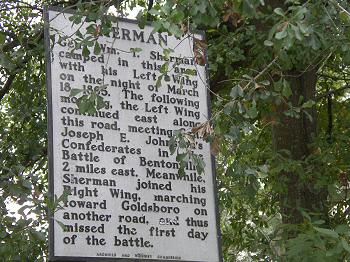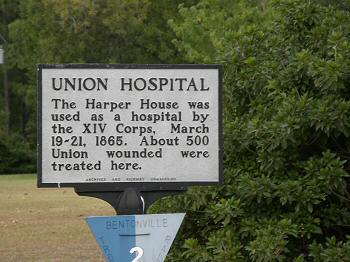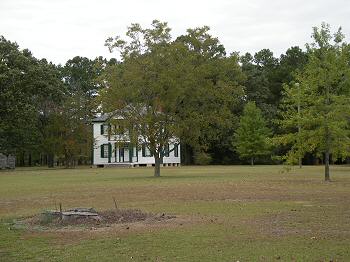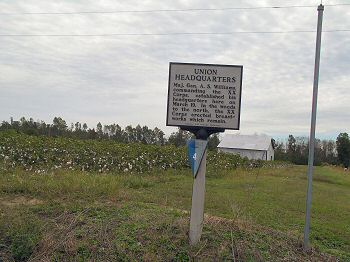Bentonville, North Carolina
|
Contributors: 1. Richard Edling, Philadelphia, PA 2. Brian Duckworth, NC For any use of these photos contact Webmaster Panoramas: 1. Tour Stop-10 2. NC Junior Reserves 3. Hardee's Counterattack 4. The Bull Pen |
Links: 1. Battle Summary: Bentonville, NC 2. Site of the Civil War Battle of Bentonville 3. Bentonville: Orders of Battle 4. Battle of Bentonville 5. The Battle of Bentonville: Caring for Casualties of the Civil War 6. North Carolina Civil War Battle Bentonville 7. North Carolina Historic Sites - Bentonville 8. Battle of Bentonville - Wikipedia, the free encyclopedia 9. Brief Chronology: Battle of Bentonville 10. North Carolina Collection-North Carolina Civil War Image Portfolio introduction 11. Bentonville Battlefield: The Site Today 12. Bentonville Battlefield: Preservation |
| Photos: |
|
|
|
The battle which took place at
Bentonville, North Carolina from the 19th through the 21st of March 1865
was the largest land battle ever fought in North Carolina. It was fought
over an area of about six thousand acres of pine woods and fields. By the
end of the fighting five hundred forty-three men were killed, over
twenty-eight hundred were wounded and the missing numbered nearly nine
hundred. Bentonville was the only significant attempt to stop Sherman on
his march northward from Atlanta, and the last major Confederate offensive
of the War Between the States. |
| Photos/text this page courtesy of Richard Edling, Philadelphia, PA |
 |
 |
|
|
(2007) Battle of Bentonville historical marker at intersection of US-701 and SH-1008 |
(2007)
Another marker at the intersection (Plaque #1) |
|
|
|
||
 |
 |
|
|
(2007)
Harper House (Plaque #2) |
(2007)
Enlarge Harper House |
|
 |
 |
|
|
(2007) Harper House (Plaque #3) |
(2007) Enlarge Union Headquarters (Plaque #4) |
Bentonville Page1 Page2 Page3 Page4 Page5 Page6 Page7 Page8 Page9 Page10 Page11 Page12 Page13 Next
Return to Sites by State Home Return to Site Index